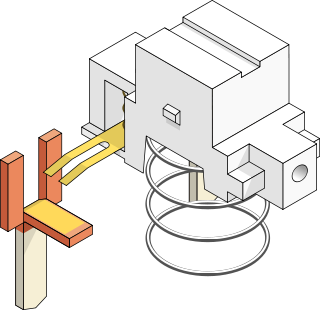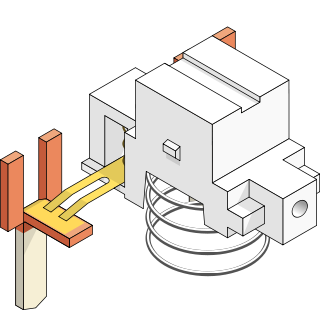RAFI RS 76 M (illuminated)
This article is a stub. You can help Deskthority by expanding it.
| This article requires photographic illustration |
 | |
| Manufacturer | RAFI |
|---|---|
| Family | RAFI RS 76 M |
| Introduced | 1975? |
| Switch type | Progressive rate momentary, latching action |
| Sense method | Metal contact |
| Rated lifetime |
10M (momentary) 100k (latching) |
| Bounce time | 10 ms |
| Total travel | 4 mm |
| Keycap mount | RAFI mount |
| Switch mount | PCB mount |
The illuminated subset of RAFI RS 76 M includes both the illuminated and latching action switches, which share a common design.
Design
The RS 76 M latching action switch is illuminable and is simply a superset of the plain illuminated design. Both switch types share the same slider: the latching action switch just adds the slide block, follower pin and follower pressure spring. There is also virtually no difference between RS 76 M and RS 76 MX: aside from the translucent plastic, RS 76 MX simply provides larger holes in the base, for SMD LEDs.
Bridge contact system
The perimeter loop design used in the non-illuminated 76 M switches does not leave space for internal LEDs. To make room for the LEDs, a different contact system was chosen. This "bridge" system comprises a thin, flat metal bar that is lowered by the slider over a pair of stationary contacts. In this form alone, mid-travel actuation would block full travel action. Instead of making the bar flexible, it is placed below a spring, and rises upwards relative to the slider while remaining motionless relative to the contacts. A minute but powerful spring ensures that the bar is held against the inside of the slider, otherwise it would fall out. The engagement of this second spring at the point of actuation gives the switch a sharp progressive rate feel: the force curve is linear but the gradient increases sharply at half travel. As such, it offers a similar counter to bottoming out as Cherry MX Clear, where you can simply release the key at the point of force increase.
The bridge contact system could be argued to be the superior option from the perspective of the operator. The bridge contact system does not come at a cost of decreased switch lifetime, but it does double the maximum contact bounce time, from the industry standard 5 ms to twice that at 10 ms. From new, the maximum contact resistance is 200 mΩ compared to 100 mΩ for the cross contacts provided by the standard perimeter loop arrangement; both are rated at 3 Ω maximum at the end of their rated lifetime.
Keyboards
- RAFI Compudent (illuminated; 1992)


